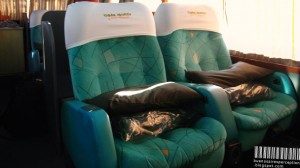Ok, ok, ok. So everyone here in Argentina pretty much says that when you travel domestically you should take a bus even if it’s 20+ hours each way. While they do mention that it is cheaper as one of the reasons, by and large they say things like:
“Argentina has really figured out how to do bus travel”
and
“It’s SO much nicer than flying”
and
“You’ll get amazing views of the countryside and first class service”
and
“With a cama-suite ticket, you’ll get a seat that fully reclines into a comfortable bed, so when you’re not being fawned over by the stewardess bringing you champagne and a wonderful multi-course meal, you can either sleep or watch movies on your personal entertainment system”
Sounds like I’m exaggerating, but I’m not. People have said things like that to us time and again. If I had been exaggerating I would have instead said something like “There’s a back section of the bus with water slides and a stadium seating movie theater; Oh yeah, and lots of pole dancers”
So–while it took us a while to get past our suspicion that no matter how nice a bus is, 20 hours on it would still suck–given all of the enthusiasm people have we decided to give it a shot and purchased our tickets for the 20 hour bus ride from Buenos Aires to Salta. We figured worst case scenario we’d get a lot of studying done en route. We dutifully asked around about which bus companies would be best and eventually settled on using Flecha Bus since they were the only ones that offered Cama-Suite which is the highest class of service. It cost ~US$95 each for a one-way ticket (we were willing to try this, but not ready to commit to a roundtrip). Now, while $95 is cheaper than the $200 plane ticket, it’s certainly not free, so you’d really hope that you were getting some value above the ~$100 dollars you saved by trading out a 2 hour flight for a 20 hour bus ride. Wouldn’t you?
We didn’t know what to expect, but given all of the hype we were fairly excited when we left for the Retiro omnibus station. The station is kind of like an airport with multiple levels and lots of different gates (called puentes).
We nervously awaited our bus’ puente to be announced and soon caught our first glimpse of what would be our home for the next 20 hours. From the outside, it looked fairly impressive.
It’s fair to say that seeing the outside of the bus and getting our luggage loaded was the peak of the trip. It was pretty much all downhill once we got inside. Perhaps the best way to continue is to address how the actual experience compared to some of the great things we had heard…
How the experience stood up to the hype
Great views of the countryside: False.
The vast majority of the ride it was night time, so nothing exciting to see out the window. While the last 4 hours or so were daylight and it was somewhat interesting to see what was outside, it’s likely the same thing we would have seen on approach to landing if we had flown–because yes, it takes the bus about 4 hours to go the same distance a plane goes while on its 10 minute approach.
Personal entertainment systems: False.
There were a few TVs mounted to the ceiling and strategically positioned such as to be difficult to see. And they played 4 movies with the volume on for the whole bus to hear whether you wanted to or not; the first one was “Over Her Dead Body”; the second was something with an alligator; the third was something about a deaf swing dance champion and the final movie was about the life of Mother Theresa<—seriously, if only we could have somehow made it louder.
Champagne: True!
We were given champagne, and in very classy, brand new champagne flutes

You might think this looks old and broken... Instead, try to think of it like premium stone washed jeans--classy right?
Meals are impressive: False.
sigh… We received 3 “meals” throughout the trip; one was a pre-dinner snack, followed by dinner, followed by breakfast. Breakfast and the pre-dinner snack consisted of the exact same shrinkwrapped styrofoam package with some cookies, a cereal bar and some unsalted crackers.
Dinner was an entirely different shrinkwrapped styrofoam pack with an unidentifiable sandwich, a dessert thing and some breadsticks. Also, we got a heated up tin foil thing full of potatoes and what we think was chicken gizzard.

In case you were wondering what Jen thought of dinner (hint: that face means she didn't like it--it's subtle, but if you look closely you can tell)
Dinner also came with wine. Which reminds me–drinks in general were tons of fun given that the cup holder on the very bumpy bus ride was about double the size of the cups that they gave us. That worked well.

Now imagine filling that with coffee and then guess how many bumps on the road it would take before it was in your lap.... Correct answer: 2
Service is truly first class: False.
Service was comical. The stewardess (or whatever the appropriate name for a bus server is) literally tossed our meals to/at us from a few feet away each time. I guess that in retrospect we are glad that all of our meals were tightly shrinkwrapped, otherwise it would have gotten messy. When not throwing “food” at us, she was nowhere to be found.
The seats are great and really comfy to sleep in: False.
It was clear that this was an old bus when we got on. When we first sat down though, we actually thought the seats were old school, but reasonably comfortable to sit in. Attempting to sleep in them was a hole (misspelling intended) different matter though. They do in fact lay back into beds, BUT, there is a massive bump right where your pelvis is (imagine sleeping on a speed bump), which regardless of what position you try is extremely uncomfortable and you sort of get the feeling that if you were to somehow fall asleep despite all of the bumping and the noise from the weird alligator movie playing on the TVs you can’t see, you would wake up having lost the ability to stand up straight ever again–lucky you, odds of falling asleep are not high (besides, if you did fall asleep, you might be awakened by a styrofoam food container smacking you in the face compliments of the friendly serving staff from the other end of the bus).
At least we can get a lot of studying done: False.
This one was really a suprise… we had a fancy overhead panel with lights and stuff, but we were surprised to discover that, when turned on, the lights were only just bright enough to be able to see what time it was on your glow in the dark watch if you squinted. Seriously, the overhead lights were not even close to being bright enough to be able to read–given that 12-14 hours of this trip took place in the dark, that kind of sucked (at least there were movies…)
Well, at least we won’t freeze to death: False.
To be fair, no one had actually told us that we wouldn’t freeze to death; I guess we just kind of assumed it and we all know what happens when we ASSUME… but really, even with 2 blankets each and our heavy coats on, we were still freezing for most of the ride. Yay hypothermia!

In case you were wondering--the bathroom sucked too (by the way, never follow a bus... pretty sure this opens directly to the road... classy)
In Summary
I really hope that this is an aberation and we somehow ended up with a bad bus, because if this experience is in fact representative of high-end bus travel in Argentina, then I have no choice but to never again trust any of the people that recommended it–or alternatively assume that this is a standard hazing/prank that they play on new people (if so, well played)
And for anyone out there that may think this sounds picky or elitist or whatever, here is my thought–If I walked into this expecting a really crappy bus ride (similar to Greyhound in the US), then I would indeed be blown away by how nice it is, BUT… people here consistently say that despite the 10x longer travel time, this is a much more comfortable way to travel and that seems crazy to me. I can accept the idea that if you’re looking to save some money and willing to put up with 20 hours of discomfort this is a lower budget way to travel (though the margin isn’t that wide–I’d say this should cost more like $30), but to really make a quality/comfort comparison vs. flying is a little bit ridiculous (unless of course there are much better buses out there… if so, let us know!)
Very good odds we’ll be flying home.
Update: We have since heard from our guide here that everyone agrees that Flecha Bus sucks and that everyone seems to really like a different company called Andesmaar which apparently does have good food, comfortable seats, wifi, personal entertainment systems and maybe even pole dancers. Oh well, we’re still flying home (and not on Aerolineas Argentina)
Update: We have now heard that Andesmaar can be very bad as well. Apparently it varies by route.





















